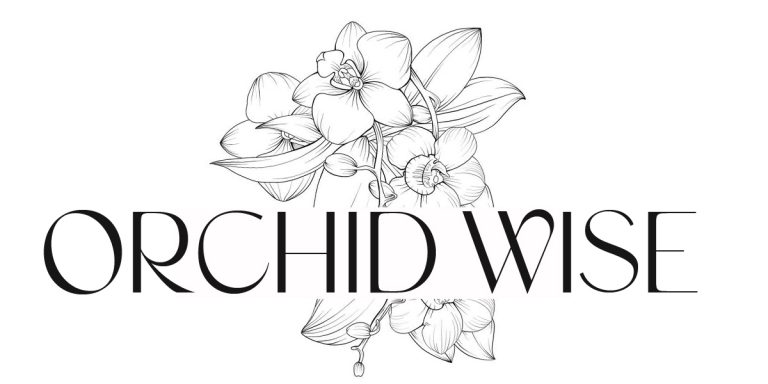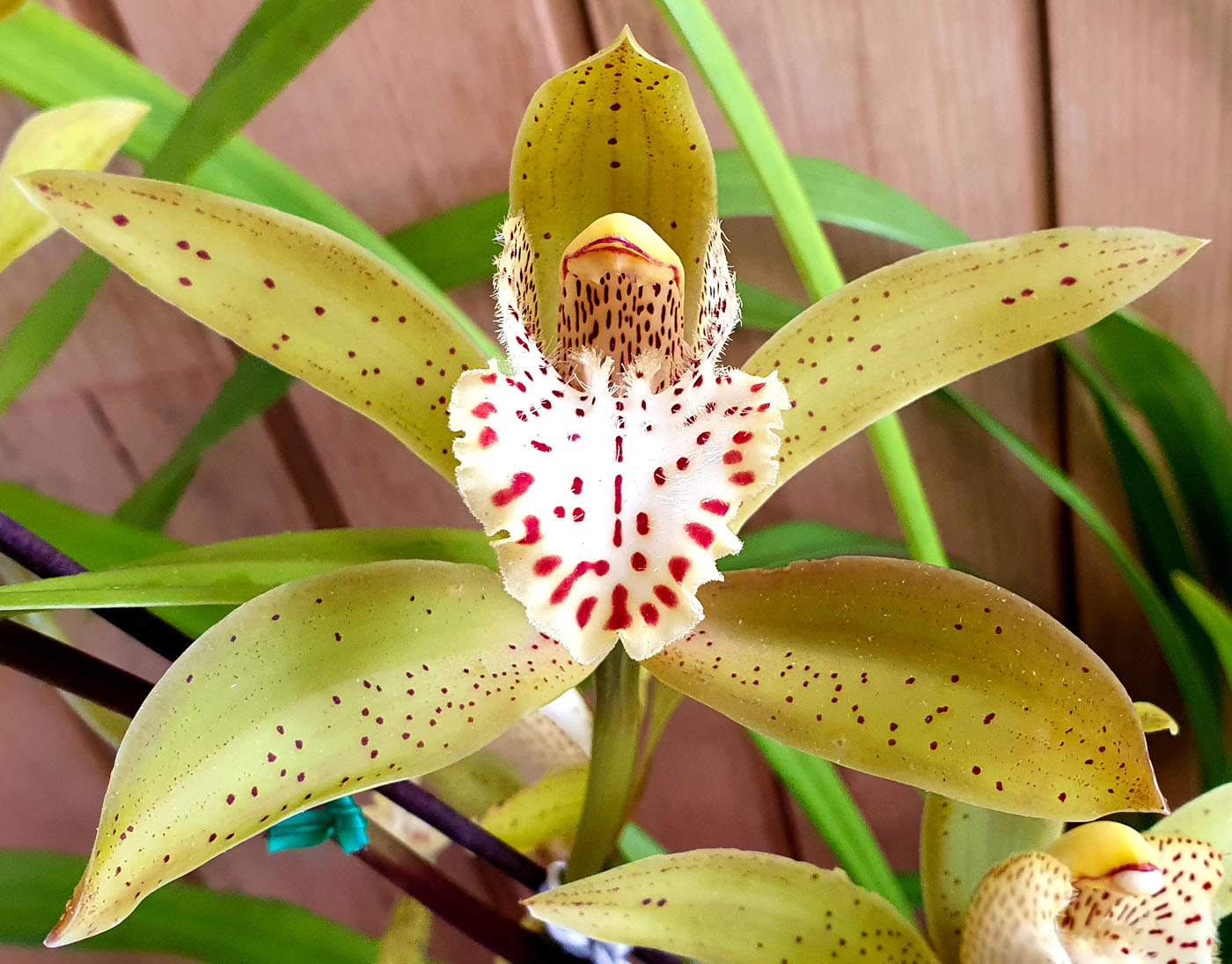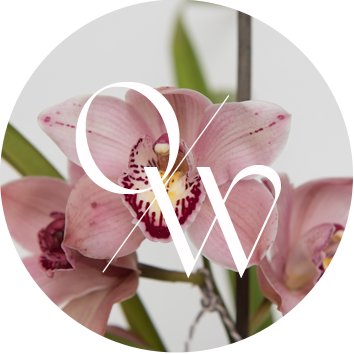Species & Primary Hybrid Orchids
Species & Primary Hybrid Orchids
The first ancestors of our modern orchids, started life growing wild, in a jungle, field, gully or some other nature area. These original ancestors are called Species Orchids.
The first generation resulting from crossing two different species Cymbidium orchids is what we call a Primary Hybrid.
Species & Primary Hybrid Orchids are my favourite Cymbidium orchid topics to talk about!
I love the wild spidery diploid flowers of both Species & Primary Hybrid Orchids and also some of the later generations of Species & Primary Hybrid Orchids hybrids. I’m also liking the tetraploid conversions of these old plants.
Unfortunately they won’t win the open class of a show bench competition these days due to the current judging guidelines, but they are far more interesting than the endlessly boring, same same, round shapes we get with today’s modern hybrids.
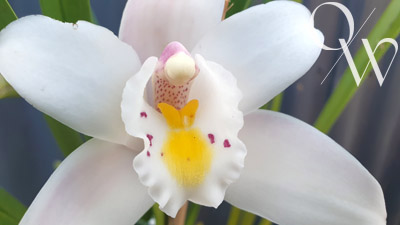
What is a Cymbidium Species Orchid?
During your Cymbidium orchid journey, you will hear the names lowianum, tracyanum, devonianum, pumilum (now reclassified as floribundum), tigrinum, ensifolium and dozens of other species names throughout your orchid journey. There are lots more, and more are still being discovered or re-classified. Usually, a particular species is found growing in isolation, away from other species Cymbidium orchids. Sometimes, the same species orchid is found growing wild in several areas, large distances apart, even in different countries. Many of them set seed, and produce new plants from those seeds. The resultant plants from these seeds can vary a little from their parents, but because they share all the same genes, are most often very similar to their parents.
Natural breeding within a species has been occurring forever, so over a long time, different forms of the same species evolved. Collectors in early days often took huge numbers of plants from the wild, and due to the different growing conditions provided, not all survived.
We now know that there are many forms of a particular species.
The same species Cymbidium collected from one area is often quite different to one collected from a separate or more remote area. The different forms of the same species are given what is known as a varietal name, to distinguish them from those from another area.
They can have different features, for example: colour, plant size, growth habit etc.
Early on, Botanists tried to classify these wild collected plants, and were often inaccurate. So it often took time for this to be corrected, and we are still continually learning about these plants and re-classifying them.

Some consider some species orchids to be rare, but they are out there.
It is more likely they are very tightly held in a collection and not readily available. Commercial growers often hold species plants for specific breeding programs and will not sell them.
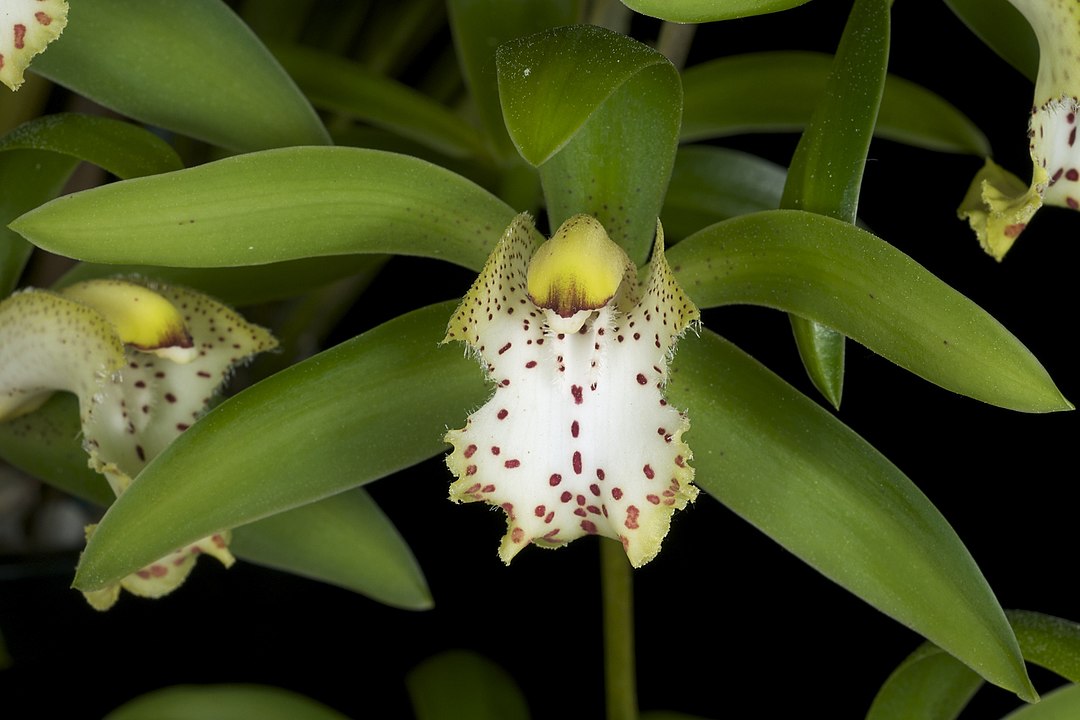
In the early twentieth century, growers started hybridising cymbidiums.
In those days, they did not have the knowledge to grow the seed produced, in sterile containers like we do today. Seed pods from cymbidium orchids can contain hundreds of thousands of very small seeds. Most seed when sown, did not germinate. Only a few plants grew, when they were sown in the pots with other mature cymbidiums.
We now know this seed required a particular fungus present on mature plants in order to germinate and grow.
Should a species orchid be mated to the same species orchid, any resultant plants are still species orchids. For example, lowianum ‘concolour’ x lowianum ‘concolour’ still produces lowianum.
This type of mating is called a selfing
Similarly a mating of two different forms of the same species cymbidium, for example floribundum ‘Album’ x floribundum ‘Pale Face’ will still produce all species floribundum plants. In both matings described above, all the new plants will be different to their parent plants, and if given a varietal name, it cannot be the same as either of their parents. They will though, most likely, be very similar to their parents. This type of mating is called a sibling cross.
A full list of species plants is a lengthy one. But a shorter list of the species Cymbidium orchids I currently grow and the year they were first described or accepted by the RHS is below. And articles with photos on these plants will be posted over time.
- Cym dayanum (1869)
- Cym. elegans (1833)
- Cym. erythrostylum (1905)
- Cym. i’ansonii
- Cym. iridioides (1825)
- Cym. mastersii (1845)
- Cym. tracyanum (1890)
- Cym. wadae (2002)
- Cym. eburneum (1896)
- Cym. erythraeum (1858)
- Cym. hookerianum (1866)
- Cym. insigne (1904)
- Cym. lowianum (1879)
- Cym. seidenfadenii (2014)
- Cym. wenshanense (1990)
- Cym. whiteae (1898)
Obviously there are different variations available in some of the species Cymbidiums, just for example Cym. dayanum is also found as an alba and also a red in addition to the standard form. Cym. erythraeum also comes in an alba, and is a favourite of mine. And others also have separate varieties, all of which are generally pretty tightly held in collections! And I am always trying to obtain all of the varieties available for each species plant!
Another hot subject related to species Cymbidium orchids and using them for breeding is ploidy. Ploidy is the term used to refer to the number of chromosome sets an orchid has. Most species Cymbidiums had forty chromosomes, made up as two sets of 20 chromosomes. They are known as Diploids, or 2N’s. Diploids are the standard level of ploidy in nature. We have a brief introduction to ploidy here and further articles will be posted in time.
What is a Cymbidium Primary Hybrid?
The resultant plants produced from a hybrid (or crossing) between two Cymbidium species orchids (for example hookerianum x tracyanum, as above), are no longer species orchids. The mating of two species orchids is often referred to as a Primary Hybrid.
These primary hybrids take on the characteristics of both parent plants, but not necessarily in equal proportions. If you are intending to try and improve your orchid collection, it is important to understand the difference between a species Cymbidium and a hybrid, and the properties of the various species Cymbidiums.
I will be adding more information on Species & Primary Hybrid Orchids when the opportunity arises, as well as photographs from my own collection.
The below photo is of one of many favourites I have – Cym. Forster Alcock which is a primary hybrid of Cymbidium tracyanum × Cymbidium elegans, first registered in 1909.
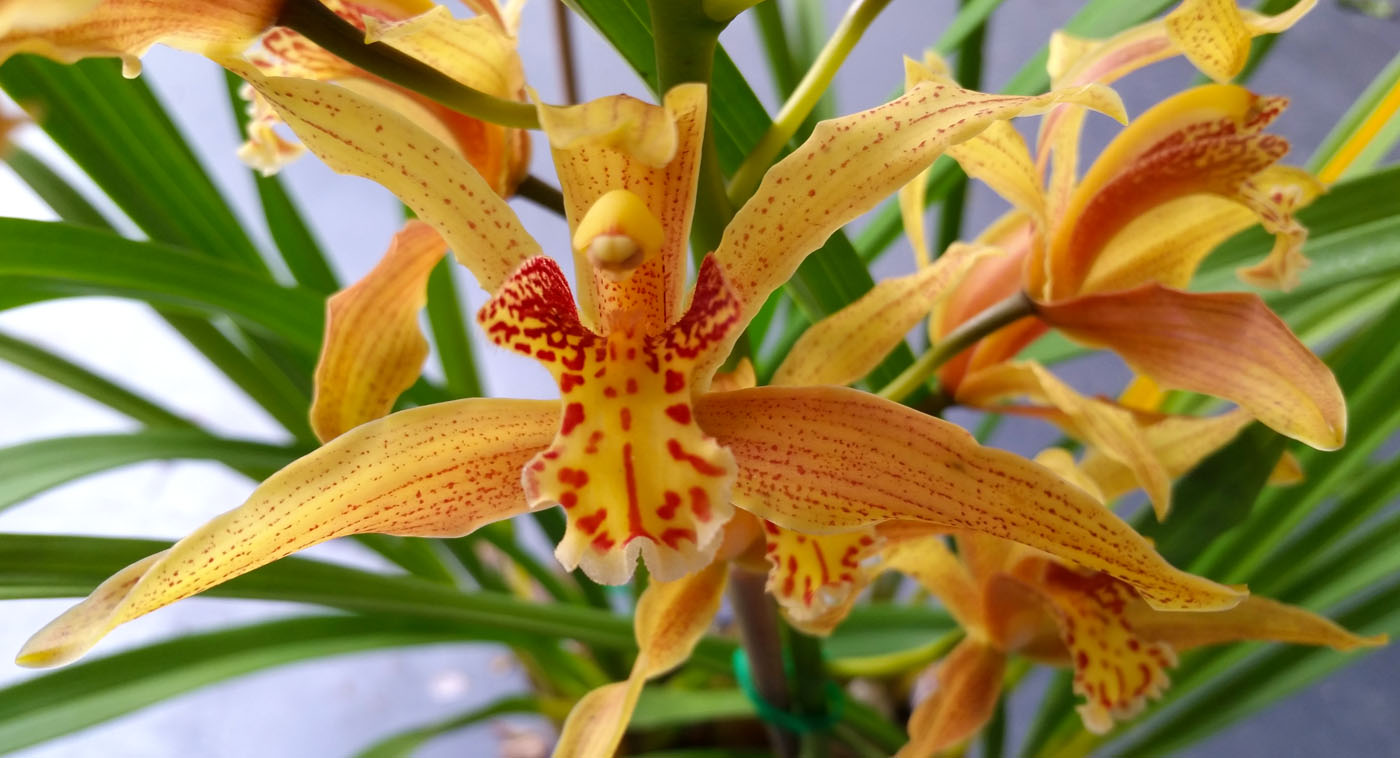
A full list of primary hybrids goes on for days! But a shorter list of the primary hybrid orchids I currently grow and the year they were first described or registered with the RHS is below. And articles with photos on these plants will be posted over time.
- Cym. Ballianum (1904) – Cym. eburneum x Cym. mastersii
- Cym. Coningsbyanum (1904) – Cym hookerianum x Cym. insigne
- Cym. Dryad (1914) – Cym. insigne x Cym sanderae
- Cym. Elsimon (1974) – Cym. elegans x Cym. Dayanum
- Cym. Forster Alcock (1909) – Cym. elegans x Cym tracyanum
- Cym. Herbie Poole (1989) – Cym. parishii x Cym. hookerianum
- Cym. Ken Siew (2009) – Cym. erythraeum x Cym. tracyanum
- Cym. Lowio-Grandiflorum (1902) – Cym. lowianum x Cym. hookerianum
- Cym. Pali (1966) – ensifolium x Cym. tracyanum
- Cym. Toni Benton (2012) – Cym. erythraeum x Cym. iridioides
- Cym. Woodlandense (1904) – Cym. mastersii x Cym. tracyanum
- Cym. Bennett-Poei (1903) – Cym. iridioides x Cym. tracyanum
- Cym. Darch Primary (2021) – Cym. iridioides x Cym. munronianum
- Cym. Doris (1912) – Cym. insigne x Cym. tracyanum
- Cym. Eburneo-Lowianum (1889) – Cym. eburneum x Cym. lowianum
- Cym. Floreat Eagland (2019) – Cym. mastersii x Cym. elegans
- Cym. Herbert George Alexander (2001) – Cym. sanderae x Cym. tracyanum
- Cym. Jean Brummit (1944) – Cym. devonianum x Cym. eburneum
- Cym. Langleyenese (1911) – Cym. devonianum x Cym. lowianum
- Cym. Osborn (2003) – Cym. erythrostylum x Cym. dayanum
- Cym. Rosefieldense (1908) – Cym. hookerianum x Cym. tracyanum
- Cym. Wiganianum (1902) – Cym. eburneum x Cym. tracyanum
As stated earlier, there are many species Cymbidium orchids. However, only a small number are used in most modern commercial and show bench breeding. Different species bring different, and useful, properties into orchid growing. It is worth studying the growing conditions and properties of these species, to help develop the collection that suits your wants.
Personally I have a great love for Species & Primary Hybrid Orchids, and they comprise the bulk of my collection.
Most of my collection were tightly held plants that are rarely seen, and even more rarely offered for sale. And it has taken many years to obtain these plants.
Given a lot of primary hybrids have either been lost over time, or seem to be unobtainable, I, along with a small group of enthusiasts are re-making some of these old hybrids to keep the history alive. If you are interested in joining us, please get in touch with me.
A great reference website compiled by Stephen Early, based in Melbourne, Australia, contains a list of all known Species and Primary Hybrid Cymbidiums that I refer to all the time, especially when considering what hybrids to make or re-make – www.cymspecies.com
Joshua White from the Cymbidium Orchid Society of Victoria has also compiled some very informative species Cymbidium information with Noe Smith. These articles are always being expanded on so check back often to see the updates. It is a site full of great information which is well worth a read and one I constantly visit – www.cosv.com.au/growing-species
Species & Primary Hybrid Orchids are worth researching!
It is well worth your time taking a look at the species & primary hybrid orchids we have. Some have really large and really fragrant flowers. Some have very small but fragrant flowers, but they have all had a valuable input in how we eventually got to the modern day hybrid.
Some initial species Cymbidium orchids worth researching are the following:
Here are some of the more important or more often used species in historical breeding – insigne, lowianum, tracyanum, floribundum (previously known as pumilum), ensifolium, devonianum
Less well known but often used in breeding – hookerianum, eryththraem, parishii, sanderae, eburneum, canaliculatum, sinense
Less often used in breeding – suave, madidum, elegans, mastersii, tigrinum, goeringii, dayanum
The remaining two thirds are not used much in breeding. Some influential breeders suggest they have little to offer to serious orchid growing, but others might suggest otherwise!
Orchid Wise Society
With over 30 years of experience joining the Orchid Wise Society is a great way to join other orchid grower enthusiasts around the world. We promise not to overload your inbox with unnecessary rubbish, instead we pride ourselves on providing relevant & interesting information with regards to all things Cymbidium orchids.
We welcome your feedback on any of the topics you have read here today and any other ones that you would find helpful.
